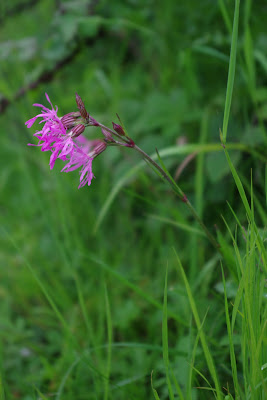In the June 15 entry for her 1906 journal, Edith Holden wrote:
It is very pretty to see the House Martins sitting in the roadway, collecting mud for their nests. Their short feathered legs look as if they had little white socks on.
I was quite surprised to come upon a bank of beautiful purple Fox-gloves today, - fully out. These are the first I have seen in flower.
On my journey to Birmingham on Tuesday the 14th of June 2016, I had made a point of noticing the wild flowers on the road side and railway embankments as noted on my
Uckfield, Sussex blog. The Virgin Pendelino had outrun the rain and cloud and, on my walk to the office, I was treated to glimpses of sunshine between heavy clouds.
 |
| House Martins under a heavy sky - June 14th. |
Above my head a group of House Martins treated me to the most tremendous aerial ballet. Over the next two days I checked the nests on the outside of the Arden hotel a few times but there was no signs that the birds were attending them. That said, the weather was so foul that I didn't stay out for very long.
Last year I saw them taking an interest in the nests from 3rd June. I discovered them because I had been checking out wildlife near the hotel as part of the Wildlife Trust's
#30DaysWild challenge, which I am repeating this year.
After work, the weather outlook was very uncertain so, having got rid of my laptop, I explored a piece of waste ground close the hotel.
 |
| Hemlock - pretty but deadly. |
Between hotel's carpark and one of the offices there is a stand of intriguing wild flowers. They looked very much like Cow Parsley but were much taller and had blotched stems. This is Hemlock, which has been deadly to ancient philosophers and children, who made peashooters from the stems, alike.
 |
| Elder flower on the edge of the hotel carpark. |
As I left the hotel grounds, I found some Green Alkanet, which was providing a free buffet for Common Carder and Early Bumble Bees. There was one, rather feeble looking Foxglove and an Elderflower bush catching the last of the summer rays.
 |
| Wild roses and office buildings. |
I had also noticed wild Dog Roses blooming. They had just started on my previous visit, two weeks before, suggesting that they are a little ahead of those that Edith described on June the 16th, 110 years ago.
Saw the first Wild Rose in bloom, - a fine pink one, on the top of a high hedge; also Blackberry in blossom. The Roses and Honeysuckle are full of bud, but they are late in bloom this year, owing to the long spell of cold weather.
 |
| Red-tailed Bumble Bee on Weld. |
A common plant on the business park is Weld, which used to be used for making dye. Here a Red-Tailed Bumble Bee was greedily feeding on the blooms.
 |
| Marmalade Hoverfly on stinging nettle. |
Following the road round, clumps of nettles provided resting places for hoverflies and 7-Spot Ladybirds. As I investigated the insects and flowers I heard a loud chatter - a family of at least five Magpies was jumping in-and-out of the bushes. A nearby Rabbit looked unimpressed with their antics. As I looked up at Pine cones in a tree, I saw a charm of Goldfinches fly towards the hotel. As the sky was darkening, I followed them.
 |
| Sheltering from the rain - June 14th. |
As I was passing the apparently empty House Martin nests on the side of the hotel, the heavens opened. I stood under a tree for a bit, finding the sound of the rain around me peaceful - but was mindful that there had been problems with flooding in Birmingham and that this meant worse was to come.





























